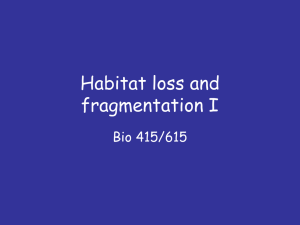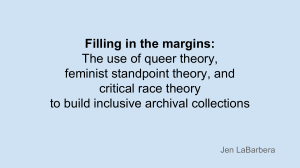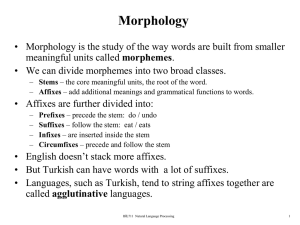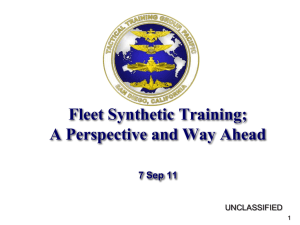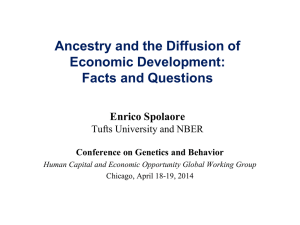Lecture 9 - math-physics
advertisement
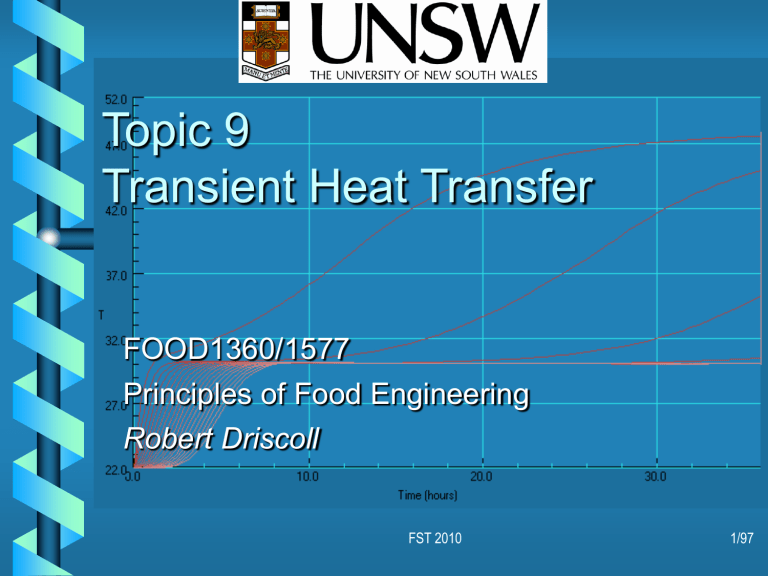
Topic 9 Transient Heat Transfer FOOD1360/1577 Principles of Food Engineering Robert Driscoll FST 2010 1/97 Introduction We need a method for calculating processing times, for example in cooking, pasteurising or sterilising a product. For example, retorting: • A can is filled with the product (leaving a small headspace) • The can is placed into a retort (a long metal cylinder which can hold pressure). • The can is steam-heated. FST 2010 2/97 Types of questions How long until centre reaches a specified temperature? How much heat is added/removed? Find final average product temperature. Calculations of lethality. FST 2010 3/97 Combined modes Can example Assume solid food. External: convection. Internal: conduction Need to calculate thermal effect. How do we combine convection and conduction? FST 2010 4/97 Steady State Steady state means state variables don’t change with time. • This means that in heat transfer, T stays constant with time, but may change with location. • Example: heat exchangers - milk pasteuriser T hold cool heat FST 2010 x 5/97 Unsteady State ‘Unsteady state’ means variables change with time (and position!) Examples: • Heating a can in a retort. • cooling of fruits and vegetables. FST 2010 6/97 General Conduction Equation We have learnt about the 3 modes of heat transfer (conduction, convection and radiation) conservation of energy dQ Q Qin Q out dt energy accumulates as internal energy: Q mcT FST 2010 7/97 Combining We can combine these equations into one powerful equation called the General Conduction Equation (GCE). The GCE can be used to solve common heat processing problems. Graphical solutions are the easiest – so that’s what we will use! FST 2010 8/97 Deriving the GCE Heat flow along a bar: q xo A dx FST 2010 9/97 Some definitions Sink – a point where heat is lost from a system Source – a point where heat enters a system FST 2010 10/97 Setting up the solution Now apply a heat balance to the element dx: HEAT ENERGY IN + HEAT GENERATED IN ELEMENT CHANGE IN INTERNAL ENERGY FST 2010 + HEAT ENERGY OUT 11/97 TERM 1: Heat Energy In Fourier’s equation at x=xo T Qin kA x FST 2010 x xo 12/97 TERM 2: Heat Generated Let qv be heat generated per unit volume: Q gen Q v Adx Useful for nonconduction terms, eg cooking, heat losses. volume FST 2010 13/97 TERM 3: Change in Internal Energy Assume no phase changes! T T Q mc cAdx t t Compare with definition of sensible heat. FST 2010 14/97 TERM 4: Heat Energy Out Fourier’s equation again … T Qout kA x T kA x x xo + dx T + dx 2 x 2 x xo x xo using a Taylor series expansion. FST 2010 15/97 Adding terms Adding and dividing by the element volume: T T k 2 + Q v c t x 2 Each term is a power density (W/m3) FST 2010 16/97 In 3 directions This equation can be generalised to 3D as follows: T k T + Qv c t 2 where the symbol indicates differentiation in three dimensions: 2 2 2 T T T 2 T 2+ 2+ 2 x y z FST 2010 17/97 Meaning of equation T k T + Q v c t 2 Heat Flow in 3D by Conduction Heat Sources or Sinks FST 2010 Sensible heat store 18/97 Some examples This equation is easy to solve for certain situations, for example: • Steady state (last term=0) • One-dimensional (which term changes?) • No sources or sinks (which term is 0?) FST 2010 19/97 Example: Steady State, 1D For steady state, 1D flow, T/t=0 k 2T x 2 + Q v 0 FST 2010 20/97 Problem If there are no heat sources or sinks, simplify the general equation. NOTE: The ratio k/c is often called the thermal diffusivity, . FST 2010 21/97 Unsteady state But the equation is hard to solve for realistic situations. To make life a little easier, solutions have been published as graphs that we can use. FST 2010 22/97 Heisler Charts A common situation is as follows: An object at uniform initial temperature Ti is dropped suddenly into a convective environment at temperature T Some typical questions: • How long until average temperature is T? • How long until centre temperature is T? • How much heat enters object? FST 2010 23/97 Diagram and TR T T T TR T Ti Ti Convective Environment Define a temperature ratio, TR: FST 2010 where T is any temperature of interest. 24/97 Thermal Resistance Outside the object is a convective environment, so R=1/hA Inside the object is a conduction environment, so R=D/kA, D=size Ratio tells us which is important: D internal hD kA Bi external 1 k hA FST 2010 Called BIOT Number 25/97 Large Biot number If Bi is large, then internal resistance is large, and we can ignore the convective resistance. Standard solutions exist for “regular” solids – spheres, cylinders etc. These solutions are based on diffusion theory. FST 2010 26/97 Small Biot Number If Bi is small, then external resistance is high, and we can ignore heat diffusion inside the solid. Then we can use a method of predicting temperatures called the LUMPED HEAT CAPACITY method: assume all of solid is at constant temperature T FST 2010 27/97 Lumped Heat Capacity If all solid is at T, then T Q hA(T T ) mc p t Solving, T hA dT 0 mcp dt Ti T T t T T e Ti T FST 2010 hA t mc p 28/97 Diagram for LHC T tc mcp hA Ti tc FST 2010 time 29/97 Example: A can of chunky soup at 1000C is left to cool on a bench in air at 20oC. Estimate how long until the soup cools to 60oC. Data: k=1.35 W/m.K A=0.02 m2 L=0.015 m h=5 W/m2.K m=0.250 kg cp=3800 W/kg.K Note: k is high, because convection in the can increases the effective rate of heat transfer. FST 2010 30/97 Check for type of problem hL 5 0.015 Bi 0.056 k 1.35 First check Bi: Since this is small, convection is slow compared to conduction. So treat as lumped heat capacity problem. FST 2010 31/97 Solution T T e Ti T 60 20 e 100 20 t 1.8 hrs FST 2010 hA t mc p 5 ( 0.02) t 0.2503800 32/97 Bi 1 So we can solve high and low Biot number problems. For Bi1, we use the charts. Charts exist for 4 regular shapes: • • • • Semi-infinite solids Thin slabs Cylinders Spheres Use these to approximate food shapes. FST 2010 33/97 1) Semi-infinite solids Definition: changes in T close to surface Or mathematically, x<<W, L, H where x • x is depth below surface • W,L,H are dimensions of object • is thermal diffusivity W FST 2010 34/97 Solution 1-TR h t k x 2 t FST 2010 35/97 Example A beef carcase at 38oC enters a cold room at 5oC. Meat density is 1042 kg/m3 thermal conductivity 0.44 W/mK, h is 20 W/m2.K, specific heat 3558 J/kgK. How cold is the meat 2 cm below the surface after 20 min? Assume “thick body response” FST 2010 36/97 Solving Thermal diffusivity is k 0.44 1.187 10 7 c p 1042 3558 Horizontal axis: x 2 t 0.02 2 1.187 10 7 20 60 FST 2010 0.838 37/97 ctd function value h 20 7 t 1.187 10 20 60 0.542 k 0.44 reading solution on vertical axis 1 TR 0.05 T 36 C o (see definition of TR) FST 2010 38/97 2) Sphere r Geometry of sphere r0 To FST 2010 39/97 Graphs sphere TRo k/hr t/r2 FST 2010 40/97 This is in the form … Dimensionless centre temperature, TRo Dimensionless time (Fourier number Fo) Reciprocal Biot number Bi. So the graph allows prediction of centre temperature at varying times. FST 2010 41/97 Example Estimate the time required for To at the centre of a 6 cm dia apple dipped in 2oC water to reach 3oC. The apple Ti is 15oC. DATA: h=50 W/m2K k=0.355 W/mK cp=3.6 kJ/kg.K =820 kg/m3 FST 2010 42/97 Method First find Bi and TR: hr 50 0.03 Bi 4.23 k 0.355 T T 23 TR 0.077 T Ti 2 15 Now read Fo from graph FST 2010 43/97 Solving Fo=0.5 So k 0.355 1.2 10 7 c p 820 3600 t r Fo / 1.1 hrs 2 Is this a realistic value? FST 2010 44/97 Can we calculate other temperatures? Define as the temperature relative to T: =T-T o=To-T i=Ti-T Following plot is X axis: 1/Bi versus Y Axis: /o showing lines of constant r/ro: FST 2010 45/97 Simplified sphere 1 /o 0 r/ro 1/Bi FST 2010 46/97 Example: To find temperature at radius r: Calculate Bi and r/ro Use graph to find /o Solve for: /i=/o x o/i (where o/i is the temperature ratio TR) Solve for = T-T= i x /o x TR (and so solve for T) FST 2010 47/97 Problem Peas (diameter = 6 mm) are blanched in hot water at 95oC. If the peas enter at 15oC, calculate the time until the centre temperature is 85oC. Data: h=1200 W/m2K, k=0.35 W/mK, cp=3.3 kJ/kgK, =980 kg/m3. FST 2010 48/97 Draw Diagram, Calcs. 1. Pea Ti=15oC T0=85oC hL 1200 31000 Bi 10.3 k 0.35 T0 T 10 0.125 2. TR Ti T 80 3. From graph, Fo=0.37 T∞=95oC FST 2010 49/97 Solving 4. k 0.35 7 2 1 . 08 10 m /s Diffusivity: c 980 3300 0.37 31 s 5. Since Fo 2 t r 1.08 10 r 1.5 0.5 6. Find T at r=1.5 mm: ro 3 t 7. So from graph 8. Solving, T=88o. 2 3 1000 7 0 .7 o FST 2010 50/97 Heat loss by sphere Calculating amount of heat lost/gained. Final graph on ‘sphere’ handout. This is a plot of X Axis: Fourier number Y Axis: Q/Qi Lines: Reciprocal Biot number FST 2010 51/97 Simplified graph 1 Q/Qi 1/Bi 0 Fo FST 2010 52/97 Meaning of graph? Qo is the amount of heat to add/remove to achieve equilibrium with the fluid: Q0 = mc(T-Ti) Q is the amount of heat actually added/removed at time t: Q = mc(Tavg-Ti) FST 2010 53/97 So for spheres: First graph relates Fo, o/i and Bi (time ... centre T ... Bi) Second graph relates Bi, /o and r/ro (Bi ... T ... radius) Third graph relates Fo, Bi and Q/Qi (time ... Bi ... heat) Given 2 of 3, use graph to find 3rd. FST 2010 54/97 Other shapes Thin plate (also called infinite plate) Q x 2L Q L << W1,W2 FST 2010 55/97 Infinite cylinder Q r << H r H FST 2010 56/97 Some uses Thin plate: • heating a steak • cooling a product which is thin in one dimension Cylinder: • cooking a sausage • cooling an extruded product FST 2010 57/97 Tutorial Problem A 5 kg fish at 70% mc is cooled by brine at -5oC from its catch temperature of 16oC. Find the temperature history of the fish at 1, 2 and 3 cm below the surface. Assume the fish is a plate of 6 cm thickness (L=3 cm): • • • • density 1000 kg/m3 thermal conductivity 0.5 W/m.K specific heat 3800 W/kg.K h=50W/m2.K FST 2010 58/97 Combining shapes Three of the four basic shapes can be combined: • ‘combined’ means intersection volume of two shapes • sphere cannot be combined! • this allows true 2D and 3D shapes FST 2010 59/97 Example infinite cylinder thin plate FST 2010 finite cylinder 60/97 Uses We can choose the cylinder radius and the thickness of the thin plate to match the dimensions of a can. We use the • cylinder solution - for heat transfer through can walls • thin plate solution - for heat transfer through can ends. An example might make this clearer. FST 2010 61/97 Example Problem: A can is suddenly dropped into a steam environment. Find its temperature at a specific point. Solution: • Find heat flow through can walls, (/i) infinite cylinder • Find heat flow through ends, (/i)thin plate • Find combined solution: (/i)=(/i)cyl x (/i)plate FST 2010 62/97 Second example Two plates: intersection gives ‘chip’ shape FST 2010 63/97 Practise Do tutorial example: cylinder (eg Holman p 163) If I combine the three basic shapes, what other shapes are possible? How could I model a chip being heated? FST 2010 64/97 Problem Can Heating A can of OD 7.5 cm and height 11.2 cm is filled with product at 25oC, sealed, and placed in a steam environment (retort) at 121 oC, construct a curve at 5 minute time intervals of the temperature at the centre of the can. Data: • • • • htc from the steam to the can is 2000 W/m2K. density 900 kg/m3. thermal conductivity 0.34 W/m.K and specific heat 3.5 kJ/kg.K, FST 2010 65/97 Solution Outline Define temperature differences o = T - To and i = T - Ti . Divide the problem into a cylinder and a thin plate. Fill in the tables (guided solution) on the following pages. FST 2010 66/97 Looking at can as cylinder Infinite cylinder of radius 3.75 cm: heat flow in centre T=To 7.5 cm FST 2010 can67/97 Cylinder Cylinder: radius = 3.75 cm. Biot number = hr/k = 2000 x 0.0375 / 0.34 = ………………………….. Thermal diffusivity = k/c = 0.34 /(900 x 3500) = ………………………..… Fourier number = t/r2 = ………… x 300/(.0375)2 = ………………………….. Temperature difference i = T - Ti = 121 – 25 = ………………………….. Now use Fig 4.9 (cylinder) to calculate the temperature ratio o/i. FST 2010 68/97 Looking at can as thin plate Width and length of plate very large H=11.2 cm centre T=To FST 2010 can69/97 Thin Plate Thin Plate: thickness 2L = 11.2 cm. Biot number = hL/k = 2000 x 0.056 / 0.34 = ………………………….. Thermal diffusivity = k/c = 0.34 /(900 x 3500) = ………………………..… Fourier number = t/L2 = ………… x 300/(.056)2 = ………………………….. Temperature difference i = T - Ti = 121 – 25 = ………………………….. Now use Fig 4.8 (plate) to calculate the temperature ratio o/i. FST 2010 70/97 Combine Solutions Combine solutions: Find the product (o/i) cyl.x (o/i) plate. = ………………………….. Since o is T - To and i is T - Ti , solve for the centre temperature To. Repeat at five minute intervals (t = 300 s), plotting a graph of centre temperature versus time. FST 2010 71/97 Solution: To for can Your values may differ slightly from these. min Fo o/i Fo 0 5 15 30 60 90 120 0.07 0.14 0.28 0.42 0.55 1 0.95 0.7 0.27 0.15 0.07 0 0.01 0.03 0.06 0.12 0.19 0.25 0.0 0.02 1 o/i 1 1 1 0.9 0.9 0.8 0.7 T 25 25 30 60 98 109 116 FST 2010 72/97 As a graph: T, C Centre Temperature 140 120 100 80 60 40 20 0 0 50 100 150 Time, min FST 2010 73/97 Relevance Thermal processing is the heart of the food industry: • heating to pasteurise/sterilise • cooling to slow reaction rates • modifying flavours • modifying water activity (drying) Reasonable approximate solutions can be found graphically using the Heisler charts. FST 2010 74/97 Types of questions How long until centre reaches a specified temperature? How much heat is added/removed? Find final average product temperature. Calculations of lethality. FST 2010 75/97 What you have learnt It is important to develop a feel for cooking/processing times. The charts can help do this! Most thermal processing is transient. Now, how can we efficiently heat on an industrial scale? Ans: STEAM ! FST 2010 76/97 TUTORIAL PROBLEMS Covering all of heat transfer FST 2010 77/97 Problem 1 A large plate of Al at 200oC is suddenly immersed in water at 70oC. The plate is 5 cm thick. Find temperature T at 1.25 cm below surface after 1 min. Assume • h=525 W/m2.K, k=215 W/m.K • =8.4x10-5 m2/s FST 2010 78/97 Solution 1 DATA: • Ti=200oC T=70oC • i=200-70=130 • 2L=5 cm so L=2.5 cm T=? • T=1 min = 60 s • x=2.5 – 1.25 = 1.25 cm First find Bi and Fo. FST 2010 79/97 Solution 1 (ctd) Fo, Bi: t 8.4 105 60 8.064 2 2 L 0.025 k 215 16.38 hL 525 0.025 x 1.25 0.5 L 2.5 From centre T graph (thin slab): o 0.61 i o To T 0.61 130 79.3 oC FST 2010 80/97 Solution 1 (ctd) From T ratio graph for a thin slab, 0.98 o T T 0.98 79.3 77.7 oC T 77.7 + 70 147.7 oC Energy loss: =2700 kg/m3, c=0.9 kJ/kg.K h 2 5252 8.4 105 60 0.03 2 2 k 215 hL 525 0.025 0.061 k 215 Q 0.41 Q0 FST 2010 81/97 Solution 1 (ctd) Qo cVi c(2 L)i A A 2700 900 0.05 130 For unit area: 15.8 106 J/m2 So heat removed is: Q 15.8 106 0.41 6.48 106 J/m2 A FST 2010 82/97 Problem 2 A large cylinder of Al at 200oC is suddenly immersed in water at 70oC. The cylinder is 5 cm in diameter. Find temperature T at 1.25 cm below surface after 1 min. Assume • h=525 W/m2.K, k=215 W/m.K • =8.4x10-5 m2/s FST 2010 83/97 Solution 2 DATA: • Ti=200oC T=70oC • i=200-70=130 • 2ro=5 cm so ro=2.5 cm T=? • T=1 min = 60 s • r=2.5 – 1.25 = 1.25 cm First find Bi and Fo. FST 2010 84/97 Solution 2 (ctd) Fo, Bi: t 8.4 105 60 8.064 2 2 L 0.025 k 215 16.38 hro 525 0.025 r 1.25 0.5 ro 2.5 From centre T graph (cylinder): o 0.38 i o To T 0.38 130 49.4 oC FST 2010 85/97 Solution 2 (ctd) From T ratio graph for a cylinder, 0.98 o T T 0.98 49.4 48.4 oC T 48.4 + 70 118.4 oC Energy loss: =2700 kg/m3, c=0.9 kJ/kg.K h 2 5252 8.4 105 60 0.03 2 2 k 215 hro 525 0.025 0.061 k 215 Q 0.65 Q0 FST 2010 86/97 Solution 2 (ctd) Qo cVi c(ro2 )i A A 2700 900 0.0252 130 For unit area: 6.203 105 J/m2 So heat removed is: Q 6.203 105 0.65 4.0 105 J/m2 A FST 2010 87/97 End of Notes FST 2010 88/97 Solutions to Heat Transfer Assignment 2009 Q1a. Find the rate of heat flow per square metre through an aluminium plate of thickness 1.8 cm if the temperature difference across the plate is 21.4oC. A1b. Simple test of Fourier’s equation: q kA T q 21.4 204 243 kW/m2 A x 0.018 FST 2010 89/97 Q1. Q1b. Find the rate of heat flow per square metre if 2 cm of insulation (k = 7.3 W/m.K) is added to the aluminium plate. A1b. Fourier’s equation: series resistance q T 21.4 7.56 kW/m2 A x1 x2 0.018 0.02 + + 204 7.3 k1 k2 FST 2010 90/97 Q2. Q2a. Steam is transported by a steel pipe (OD=5.1 cm) from a boiler to a double-jacketted kettle at 1 kg/min. The length of pipe is 26.4 m, and the steam temperature is 121.1oC. Assume h is 20 W/m2.K: Estimate the heat losses per unit length (Ta=25oC) A2a. Convection equation: cylinder q / L hAT / L 20 0.051 121.6 25 308 W/m FST 2010 91/97 Q2b Find the steam dryness factor at the kettle. A2b. Dryness is defined as proportion of steam to total (total includes liquid condensate): htotal d .hsteam + 1 d .hwater hwater + d Equate energy loss in steam to pipe wall loss: qloss qloss per unit length L pipe m steam h m steamd 308 26.4 W 1 / 60 2707.44 507.97 d d 0.22 This gives a steam dryness of 0.78. FST 2010 92/97 Q2c How much insulation (at k=0.14 W/m.K) would be required to obtain steam at a dryness of 0.90? A2c. This tests resistances in series, insulation and dryness equation. (i) Addition of insulation of thickness x: lnrnew rold 1 Rtotal + h2Lrnew 2Lkins Energy loss m steam d . T Rtotal Rtotal T m steam d . 121.1 25 / 601 0.1 2199.47 0.02622 Second term in Rt is most important : solve by iteration. FST 2010 93/97 Rewrite Rt equation to solve for rnew: 1 0.00700 0.6089 lnrnew rold 2Lkins Rtotal h2Lrnew rnew Try rnew=0.04 then iterate: rnew 0.04 0.0394 0.03924 0.03924 thickness 0.03924 0.0255 1.4cm FST 2010 94/97 Q3. Q3a. Heat flow per unit length through Cu pipe, thickness 1.2 cm, internal diameter 0.8 cm, surrounded by 4.3 cm of fibreglass, if the fluid is at 350oC, ambient is 20oC, h is 17 W/m2.K A3a. Geometry shown opposite. 1 lnr3 r2 lnr2 r1 Rtotal + + 2k Cu 2k Ins 2hr3 Conv 5.7 10 4 + 5.92 + 0.16 K/W q 0.8 1.2 350 20 T 54 W /m Rtotal 6.08 FST 2010 4.3 95/97 Q3b. What is the critical thickness of insulation? rcrit k 0.0351 3 2.06 10 m h 17 FST 2010 96/97 Q4. Q4. Find the centre temperature of a 2cm thick beef steak at 20oC suddenly exposed to an environment at 500oC, h=500 W/m2.K, five minutes after exposure. A4. Typical meat values: k=0.4-0.5 W/m.K, =1050 kg/m3, c=3500 kJ/kg Solving: =1.3x10-7 Bi=0.095 Fo=0.38 Chart (use thin slab): 0/i = 0.63 Solving, To=160-200oC FST 2010 97/97 Q5. German sausage A cylindrical sausage of meat is hung in an air-drying room at 45oC. • Plot centre T at 1 hourly intervals. • Plot T at 1 cm from centre. • Plot average T. DATA: • sausage: r=5 cm, h=45 cm • density: 980 kg/m3 • therm cond: k=0.47 W/m.K Ti=25oC htc: h=10 W/m2.K spec heat: c=3.55 W/kg.K Solution (1 hour) 1.351x10-7 m2/s Thermal diffusivity =k/c = ………… Biot number 0.195 Fourier number Fo=t/ro2= …………. Use Fig 4.8 (check!): 1.064 Bi=hr0/k= …………. • Centre T at 1 hour: • So To = 27oC o/i= …………. 0.90 FST 2010 99/97 Use Fig 4.11 at 1 cm from centre: • r/r0=0.20 0.98 • So /o= ……………. 27.4oC • So T1 = ……………. Use Fig 4.15 to find Tavg: 0.22 • FoBi2 = ……………. 0.40 • So Q/Qo= ……………. 33oC • So T1 = ……………. FST 2010 Qo=mc(T-Ti) Q mcTavg Ti Q0 mcT Ti Tavg Ti + Q T Ti Q0 100/97 Now can you find out the three T’s at 2 hours? (easier!). FST 2010 101/97

